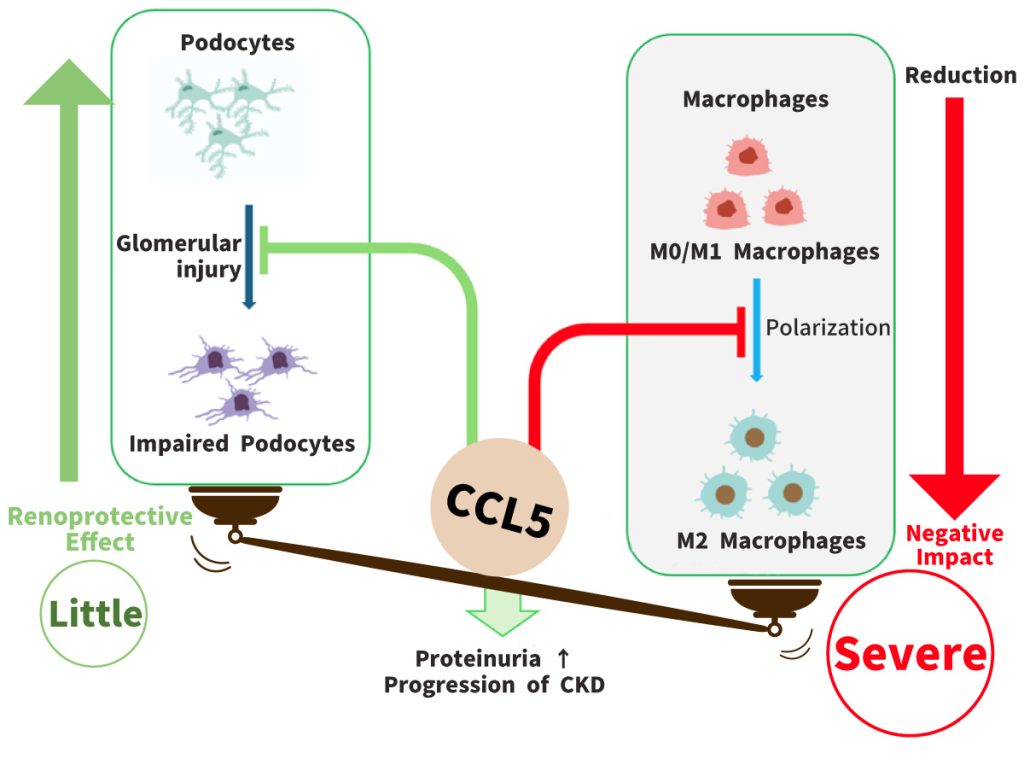Study finds the molecule CCL5 is both protective and harmful, suggesting future drugs could target only its damaging effects
Researchers at Chiba University have identified a key molecule, CCL5, that plays a dual role in chronic kidney disease (CKD). While it protects specific kidney cells, it simultaneously worsens overall damage by promoting harmful inflammation. By developing treatments that precisely target the damaging effects of CCL5 without blocking its protective functions, scientists believe they could create smarter therapies to slow CKD progression and reduce the need for dialysis.

Image title: Conceptual diagram highlighting the dual role of CCL5 in the kidney
Image caption: CCL5 protects podocytes, the kidney’s essential filtration cells, but simultaneously drives harmful inflammation. Ultimately, these damaging effects surpass its protective role, leading to progressive kidney damage.
Image credit: Professor Katsuhiko Asanuma at Chiba University, Japan
Image license: Original content
Usage Restrictions: Cannot be reused without permission.
Chronic kidney disease (CKD) is a progressive condition in which the kidneys gradually lose their ability to filter waste from the blood. It is a common health concern that affects an estimated 8–16% of the global population, particularly among older adults. CKD can arise from various causes, including glomerulonephritis, a group of diseases that damage the glomeruli, the tiny filtering units within the kidneys.
Now, researchers from Chiba University have identified a molecule called C-C chemokine ligand 5 (CCL5) as a key player in kidney injury and repair. Their findings reveal that CCL5 behaves in two distinct ways: it can protect certain kidney cells, called podocytes, which are specialized cells that wrap around the glomerulus and form the final barrier of the kidney filter; however, at the same time, it can exacerbate overall kidney damage.
The study was led by Professor Katsuhiko Asanuma of the Graduate School of Medicine, Chiba University, Japan, together with Professor Motoko Y. Kimura and Lecturer Ryo Koyama-Nasu of the Graduate School of Medicine, Chiba University, as well as Ika N. Kadariswantiningsih, Issei Okunaga, and Kaho Yamasaki from the Graduate School of Medicine and Pharmaceutical Sciences, Chiba University. Their findings, published online on September 23, 2025, in JCI Insight, a journal of the American Society for Clinical Investigation, may pave the way for more precise treatments for CKD.
CCL5 is a signaling molecule, or chemokine, that helps immune cells move toward sites of inflammation. It was first identified in T cells, but later research showed that it is also produced by other cell types, including epithelial cells around the glomeruli known as podocytes, which act as the final layer of filtration. As a result, CCL5 plays both helpful and harmful roles, supporting immune defense on one hand but promoting inflammation and tissue damage on the other.
Previous studies produced conflicting results about the effects of CCL5, with some suggesting that it protects the kidneys, while others indicated that it worsens injury. To clarify CCL5’s role in CKD, the Chiba University team analyzed kidney tissue from patients with various glomerular diseases and from mice with Adriamycin (ADR)-induced nephropathy, a model that closely mimics human kidney disorders such as focal segmental glomerulosclerosis.
In both humans and mice, they found that CCL5 levels were much higher in damaged glomeruli and were closely linked to podocytes, the cells that maintain the filtration barrier.
Next, the researchers carried out experiments using both laboratory-grown podocytes and live mice. In the lab, treating podocytes with CCL5 helped them survive and reduced cell death, suggesting a protective effect. However, in the mice, which developed kidney disease, higher CCL5 levels exacerbated damage, causing more protein to leak into the urine, more scarring of kidney tissue, and greater loss of podocytes.
To understand why this happened, the team examined the role of immune cells. When they transplanted bone marrow from mice lacking CCL5 into normal mice, the recipients showed reduced kidney damage. This indicated that CCL5 produced by immune cells, rather than kidney cells, was responsible for worsening the disease. Further analysis showed that CCL5 promoted inflammatory ‘M1’ macrophages while reducing the number of healing ‘M2’ macrophages. In other words, it shifted the balance toward inflammation rather than repair. “The harmful immune effects of CCL5 outweigh its protective role in podocytes, leading to proteinuria, glomerulosclerosis, and podocyte loss,” explains Prof. Asanuma.
These results highlight a new approach for developing future treatments for CKD. Instead of broadly blocking inflammatory pathways, therapies could be designed to support the body’s own repair mechanisms while limiting the harmful immune responses that cause kidney damage.
“The insights gained from CCL5’s dual role could guide the development of cell-targeted drugs that block its harmful immune effects without interfering with its protective actions in podocytes. If such therapies become available, patients could benefit from slower CKD progression, fewer cases requiring dialysis or transplantation, and better preservation of kidney function and quality of life,” says Prof. Asanuma.
To see more news from Chiba University, click here.
About Professor Katsuhiko Asanuma from Chiba University, Japan
Katsuhiko Asanuma is a Professor in the Department of Nephrology at the Graduate School of Medicine, Chiba University, Japan. His research focuses on understanding the mechanisms that drive chronic kidney disease and developing new treatments to prevent its progression. In addition to laboratory research, he also conducts clinical studies on patient education, rehabilitation, and AI-assisted care for dialysis patients, aiming to improve kidney health and reduce dialysis dependency in Japan.
Funding:
This work was partly supported by a Ministry of Education, Culture, Sports, Science and Technology of Japan Grant-in-Aid for Scientific Research 17K19653, 18H02823.
Reference:
Title of original paper: CCL5 paradoxically regulates glomerular injury by skewing macrophage polarization
Authors: Ika N. Kadariswantiningsih1,2, Issei Okunaga1, Kaho Yamasaki1, Maulana A. Empitu1,2, Hiroyuki Yamada1,3, Shin-ichi Makino1, Akitsu Hotta4, Hideo Yagita5, Masashi Aizawa1, Ryo Koyama-Nasu6, Motoko Y. Kimura6, Narihito Tatsumoto1, and Katsuhiko Asanuma1
Affiliations:
- Department of Nephrology, Graduate School of Medicine, Chiba University
- Faculty of Medicine, Airlangga University
- Department of Nephrology, Kyoto University Hospital
- Department of Reprogramming Science, Center for iPS Cell Research and Application (CiRA), Kyoto University
- Division of Cell Biology, Biomedical Research Center, Juntendo University Graduate School of Medicine
- Department of Experimental Immunology, Graduate School of Medicine, Chiba University
Journal: JCI Insight
DOI: 10.1172/jci.insight.173742
Contact: Katsuhiko Asanuma
Graduate School of Medicine, Chiba University, Japan
Email: jinnai@office.chiba-u.jp
Academic Research & Innovation Management Organization (IMO), Chiba University
Address: 1-33 Yayoi, Inage, Chiba 263-8522 Japan
Email: cn-info@chiba-u.jp
Recommend
-

Mimicking the 500 million years of plant survival strategies to create a sustainable future
2023.01.14
-

‘Synergistic Campus Evolution with the Community’ Chiba University Design Research Institute (Part 1): The Entire Campus as a ‘Design Experiment Space’
2023.12.21
-

Plant factory: sustainable plant production on Earth and in outer space
2022.10.06


